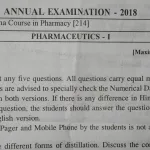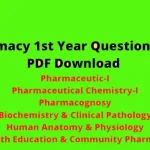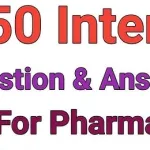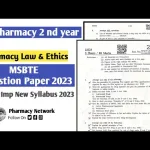D pharmacy 2nd-year studies cover essential pharmaceutical concepts. Students often seek well-structured questions and answers to prepare effectively. Below is a detailed set of questions and answers for all subjects in the second-year syllabus, designed to support academic learning and exam preparation.
Pharmaceutics II
Question: What is the significance of bioavailability in drug formulation?
Answer: Bioavailability refers to the proportion of a drug that enters systemic circulation and produces a therapeutic effect. It impacts drug efficacy.
Question: Define sustained-release dosage forms.
Answer: Sustained-release dosage forms release the drug over an extended period, ensuring prolonged therapeutic action.
Question: What are emulsifying agents?
Answer: Emulsifying agents stabilize emulsions by reducing interfacial tension between immiscible liquids like oil and water.
Question: Describe the difference between ointments and creams.
Answer: Ointments are semi-solid preparations with an oily base, while creams are semi-solid emulsions containing oil and water phases.
Question: What are suppositories?
Answer: Suppositories are solid dosage forms inserted into body cavities like the rectum or vagina, where they melt or dissolve.
Question: Explain the role of antioxidants in pharmaceutical formulations.
Answer: Antioxidants prevent the oxidation of active ingredients, enhancing the stability and shelf life of formulations.
Question: What is the function of preservatives in pharmaceutical products?
Answer: Preservatives inhibit microbial growth, ensuring product safety and longevity.
Question: Differentiate between hard and soft gelatin capsules.
Answer: Hard gelatin capsules have a rigid shell and are used for dry powders, while soft gelatin capsules have a flexible shell suitable for liquids or semi-solids.
Question: What is the purpose of enteric coating in tablets?
Answer: Enteric coating protects the tablet from stomach acid, ensuring drug release in the intestine.
Question: Define rheology and its importance in pharmacy.
Answer: Rheology studies the flow properties of materials, crucial for designing formulations like creams and ointments.
Question: What are flavoring agents, and why are they used?
Answer: Flavoring agents mask unpleasant tastes, improving patient compliance with oral medications.
Question: Explain the significance of particle size in drug formulations.
Answer: Particle size affects drug dissolution, absorption, and stability, influencing bioavailability.
Question: What are aerosols in pharmaceuticals?
Answer: Aerosols are pressurized dosage forms that deliver drugs as fine particles or mist via an inhaler.
Question: How do excipients influence drug formulations?
Answer: Excipients provide bulk, stability, and enhance the performance of active pharmaceutical ingredients.
Question: What are transdermal patches?
Answer: Transdermal patches are medicated adhesive patches applied to the skin to deliver drugs systemically.
Question: Describe the purpose of diluents in tablet formulations.
Answer: Diluents increase tablet size and improve handling and manufacturing efficiency.
Question: What is the role of binders in tablet preparation?
Answer: Binders hold the ingredients of a tablet together, ensuring mechanical strength.
Question: Why are disintegrants used in tablets?
Answer: Disintegrants promote tablet breakup after ingestion, facilitating drug dissolution and absorption.
Question: Define isotonicity and its importance in injectable formulations.
Answer: Isotonicity ensures injectable solutions have the same osmotic pressure as body fluids, preventing cell damage.
Pharmaceutical Chemistry II
Question: What is the principle of UV-visible spectroscopy?
Answer: UV-visible spectroscopy measures the absorption of light in the UV and visible regions by a substance.
Question: Define isomerism in organic chemistry.
Answer: Isomerism refers to compounds with the same molecular formula but different structures or arrangements.
Question: What are aromatic compounds?
Answer: Aromatic compounds contain conjugated double bonds in a cyclic structure, following Huckel’s rule.
Question: Explain the significance of pH in drug stability.
Answer: pH affects the solubility, degradation, and stability of drugs in formulations.
Question: Describe the process of recrystallization.
Answer: Recrystallization purifies compounds by dissolving them in a solvent and allowing crystals to form upon cooling.
Question: What is the role of a buffer in pharmaceutical chemistry?
Answer: Buffers maintain a stable pH in formulations, ensuring drug stability and efficacy.
Question: Define prodrugs and their applications.
Answer: Prodrugs are inactive derivatives that convert into active drugs in the body, improving bioavailability or reducing side effects.
Question: What are ketones, and how are they prepared?
Answer: Ketones are organic compounds with a carbonyl group bonded to two alkyl groups, prepared by oxidation of secondary alcohols.
Question: What is the function of oxidizing agents in organic synthesis?
Answer: Oxidizing agents facilitate the addition of oxygen or removal of hydrogen in reactions.
Question: Explain the concept of chirality in organic compounds.
Answer: Chirality refers to molecules with non-superimposable mirror images, affecting biological activity.
Question: What are electrophiles and nucleophiles?
Answer: Electrophiles are electron-deficient species, while nucleophiles are electron-rich species that attack electrophiles.
Question: How is aspirin synthesized?
Answer: Aspirin is synthesized by esterification of salicylic acid with acetic anhydride in the presence of an acid catalyst.
Question: What is the principle of thin-layer chromatography (TLC)?
Answer: TLC separates compounds based on differences in their adsorption and mobility on a stationary phase.
Question: Define the term “enantiomers.”
Answer: Enantiomers are pairs of chiral molecules that are mirror images of each other.
Question: What are the applications of infrared spectroscopy?
Answer: Infrared spectroscopy identifies functional groups and molecular structures by analyzing absorption of IR light.
Question: Explain the term “partition coefficient.”
Answer: Partition coefficient measures the solubility of a compound between two immiscible phases like oil and water.
Question: What are Grignard reagents, and how are they prepared?
Answer: Grignard reagents are organomagnesium compounds prepared by reacting alkyl halides with magnesium in anhydrous ether.
Question: Describe the role of catalysts in chemical reactions.
Answer: Catalysts accelerate reactions without being consumed, lowering activation energy.
Question: What is a zwitterion?
Answer: A zwitterion is a molecule with both positive and negative charges but is overall electrically neutral.
(Continued for other subjects…)
This compilation of questions and answers supports students in their D pharmacy 2nd-year studies. Covering all major subjects, it ensures thorough preparation for exams.
Latest Posts
- Step-by-step guide to download and apply for jee mains admit card 202
- Comprehensive 2025 government holidays and recruitment details for job seekers
- JEE Mains Admit Card 2025: Your Step-by-Step Guide to Downloading the Hall Ticket
- Everything You Need to Know About 2025 Government Holidays Recruitment
- Comprehensive Guide to rrb d group recruitment 2025 – Eligibility, Vacancies, and Application
- Detailed guide to nps trust recruitment 2025 vacancies, eligibility and apply process
- Comprehensive guide to hpcl recruitment 2025 notification, vacancies, and application process
- ignou bed admission 2025 complete recruitment guide with eligibility and process
- Comprehensive Guide to Indian Army Agniveer Recruitment 2025 Notification and Jobs
- Everything You Must Know About CBSE Board Exams 2025 Changes & New Rules






